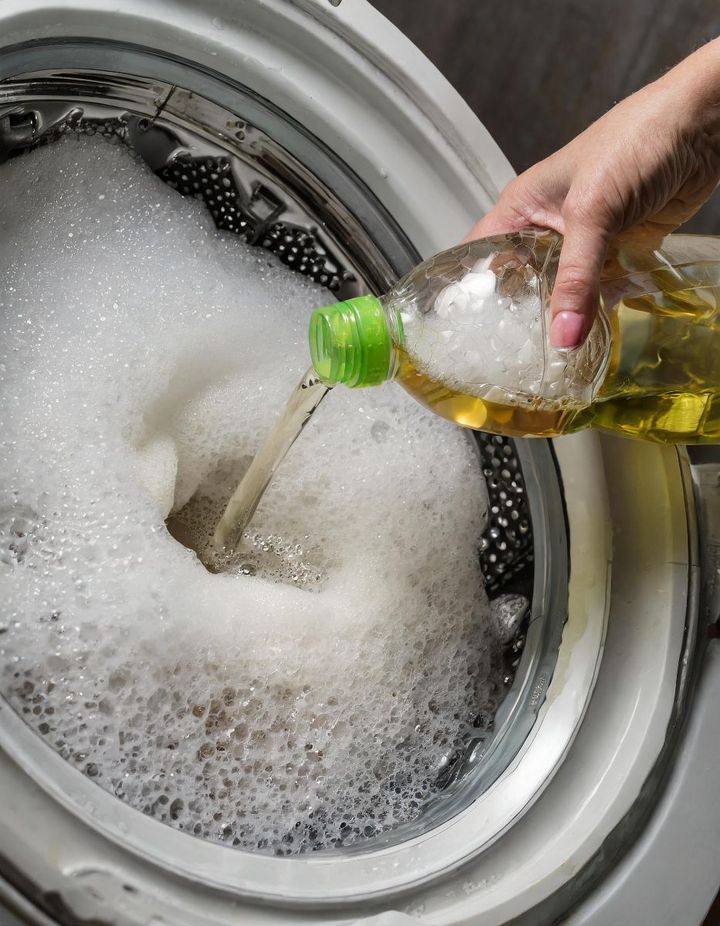ADVERTISEMENT
2. Softening Towels
Towels can get stiff and scratchy over time due to detergent build-up, fabric softener residue, or minerals in the water. Vinegar softens fabric naturally, leaving your towels plush and absorbent.
- How to Use: Add 1/2 cup of white vinegar to the fabric softener compartment of your washing machine. You can also add it directly to the drum during the rinse cycle if you’re washing a small load.
- Why it Works: Vinegar helps to break down detergent and fabric softener residues that can make towels feel rough and stiff. It also helps to maintain the absorbency of the towels by dissolving minerals that may interfere with fabric fibers.
3. Preventing Static Cling
If static cling is a problem in the dryer, vinegar can help. It neutralizes the build-up of static electricity that causes fabrics to stick to each other.
- How to Use: Add 1/4 cup of vinegar to the fabric softener compartment during the rinse cycle. You can also toss a wet washcloth with vinegar into the dryer alongside your clothes to reduce static.
- Why it Works: Vinegar helps balance the pH of the laundry, reducing the charge that causes static. Unlike traditional fabric softeners that coat fabrics with a thin layer of chemicals, vinegar works naturally to prevent cling without leaving behind residue.
4. Removing Odors
Vinegar’s natural deodorizing properties help to remove stubborn odors, like those from musty towels, sweat, or lingering detergent scents.
- How to Use: Add 1/2 cup of white vinegar to the wash cycle to neutralize odors. If you’re dealing with particularly stinky clothes (like workout gear or pet bedding), you can use up to 1 cup of vinegar. Let the vinegar sit on the fabrics for about 15-30 minutes before starting the wash cycle for extra deodorizing power.
- Why it Works: Vinegar helps neutralize bad smells by breaking down the molecules that cause odor. It also eliminates lingering smells from detergent or softener, leaving your laundry smelling fresh.
5. Pre-Treating Stains
Vinegar can work as an effective pre-treatment for stains, particularly when combined with baking soda for tough spots like sweat marks, deodorant stains, or grease.
- How to Use: Apply undiluted white vinegar directly to the stain and let it sit for 10-15 minutes. For stubborn stains, you can make a paste by mixing vinegar with baking soda and gently scrubbing the area. Then wash as usual.
- Why it Works: The acetic acid in vinegar helps break down oils, grease, and sweat that can leave stains on fabric. It’s particularly useful for removing deodorant or sweat stains from shirt armpits.
Common Mistakes People Make When Using Vinegar
While vinegar is an amazing laundry booster, many people make a few mistakes that prevent it from working at its best. Here are the common pitfalls to avoid:
- Using Too Much Vinegar: While vinegar is safe to use, too much of it can leave an odor behind. Stick to 1/2 cup to 1 cup per load (depending on load size), and avoid overusing it.
- Mixing Vinegar with Bleach: Never combine vinegar and bleach. While both are effective cleaners, together they create harmful chlorine gas. Always use them separately in different cycles if needed.
- Not Using It in the Right Cycle: To get the full benefits of vinegar, it needs to be added at the right time in the laundry cycle. For whitening and softening, add vinegar during the wash cycle, not the rinse cycle. For odor removal, add it to the rinse cycle.
- Using It on Delicate Fabrics: While vinegar is generally safe, some delicate fabrics (like silk or wool) may react negatively to the acidity. Always check the care instructions for delicate fabrics before using vinegar.
Conclusion
Vinegar is a laundry game-changer when used the right way. From whitening whites and softening towels to removing odors and preventing static, this humble pantry staple is more versatile than most commercial cleaners. To get the best results, remember to use white vinegar (not apple cider vinegar) and add it at the correct time during your laundry cycle.
By incorporating vinegar into your regular laundry routine, you’ll save money, reduce your use of chemicals, and enjoy softer, fresher-smelling clothes and linens. So, next time you do laundry, put vinegar to work—just make sure you’re using it correctly to get the most out of this powerful, natural cleaner!
ADVERTISEMENT
